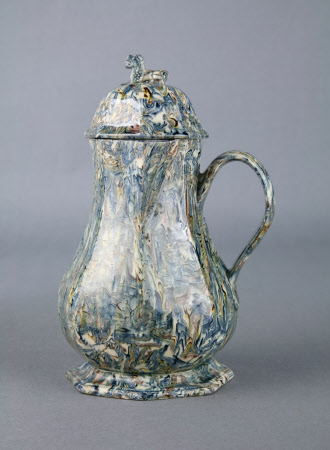Coffee pot
Category
Ceramics
Date
1750 - 1760
Materials
Earthenware
Measurements
235 x 160 mm
Place of origin
Staffordshire
Order this imageCollection
Treasurer's House, North Yorkshire
NT 592369
Summary
Coffee pot and cover, agateware (earthenware) with lead glaze, probably Staffordshire, ca 1750-60. The body is an octagonal baluster form with spreading foot, beak-shaped spout with an internal pierced strainer, the cover domed with knop in the form of a Chinese-style lion, simple loop handle at right-angles to the projecting lip.
Full description
Frank Green (1861-1954) gave Treasurer’s House to the National Trust in 1930. His gift included some important ceramics, though some of the pieces shown in the house today were added by the National Trust from the 1970s to 1990s. The display of British pottery in the Dining Room, which includes this coffee pot, is part of Frank Green’s original collection. It is described in an inventory taken in 1930 as ‘A Whieldon agate ware jug and cover, octagonal shape 9 1/2" high.’This coffee pot is made from a type of ceramic called agate ware, as it was made to imitate agate stone, a type of chalcedony that has bands of different colours running through it. Agate ceramics were very popular in Britain during the 1750s and a number of potters made objects using it. Writing in 1759, the Staffordshire potter Josiah Wedgwood describes the wares he made in collaboration with his partner, Thomas Whieldon, in 'imitation of Agat which was esteem'd very beautiful'. Agate ware is made from a solid body of different coloured clays, marbled together. This could then be thrown on a wheel to form an object, or made into blocks and rolled into sheets to create objects in a mould - like this coffee pot. Other types of agate ware are decorated using marbled glazes, rather than from solid marbled clays.The octagonal shape is influenced by tea and coffee pots made in silver during the earlier part of the eighteenth century. See also British Museum (1923,0122.14.CR) for a very similar form with a circular base, rather than octagonal, attributed to Thomas Whieldon, Staffordshire. A coffee pot at the V&A (296-1869) is also of a very similar form, the handle with a raised thumb rest and scroll terminal to the handle.
Provenance
Given by Frank Green (1861-1954) along with house, garden and contents to the National Trust in 1930
Marks and inscriptions
no marks
